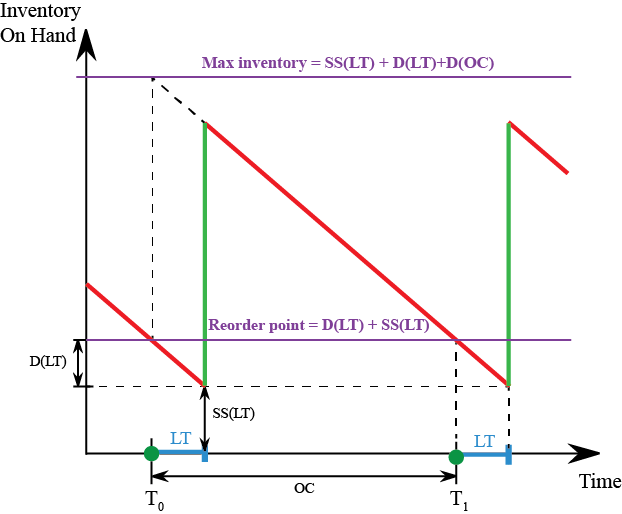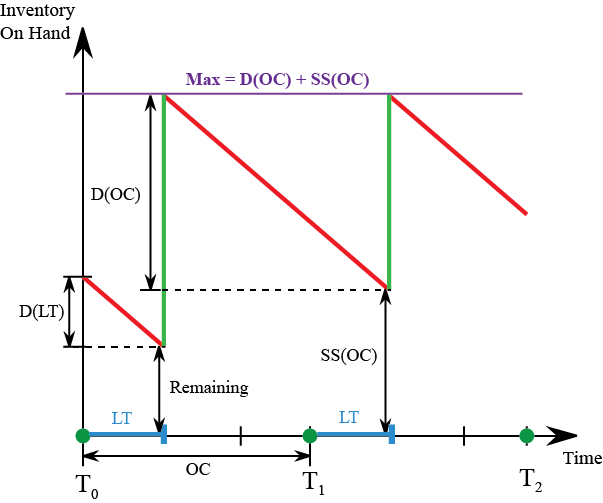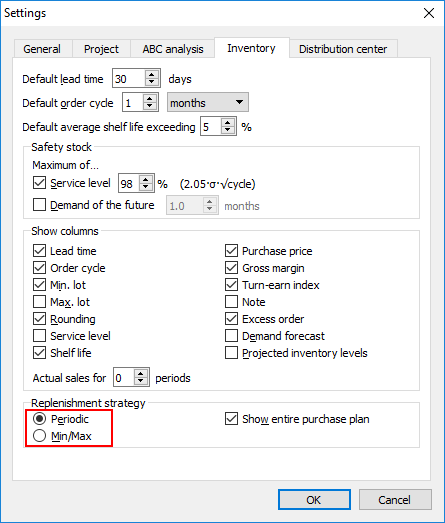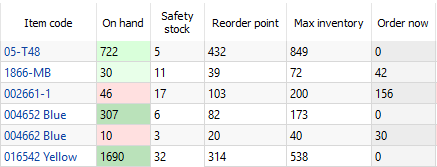Table of Contents
6.1. Inventory Replenishment Strategies
In this article we:
- indicate the strategies which Streamline supports and explain how they drive the replenishment process;
Replenishment strategies and lot-sizing methods
There are two fundamentally different replenishment strategies depending on the overall objective: 1) placing orders at any time or 2) at specific time points:
- Min/max (or Reorder point) strategy. In this strategy inventory levels are continuously reviewed and as soon as the stocks fall below a pre-determined level (usually called, reorder point, or reorder level), a replenishment order is placed.
- Periodic strategy. The inventory levels are reviewed at a set frequency. Depending on specific inventory needs, a replenishment order can be placed or not, but only at the review point.
The goal of a replenishment strategy is to determine:
- safety stock level – a stock buffer used to protect against the random fluctuations in demand and/or supply, and
- replenishment plan – a schedule reflecting how much you should order today and in the near future.
These factors are based on the given service level and other data. In the case of the Min/max strategy, the outcomes of the strategy also include the reorder point and max inventory level.
Both strategies use a lot-sizing method to determine the optimal lot size. The method selected should be the most efficient for a given demand pattern. The effectiveness is determined by the trade-off between the SKU (item) carrying costs and the costs of ordering it from the supplier. In the case of the Periodic strategy, this compromise also indicates the future periods in which replenishment orders should be issued, i.e. determines the order cycle – the time between two successive replenishment orders. Order cycle can be constant or variable depending on the lot-sizing method. Here is a list of commonly used lot-sizing methods:
- Fixed order quantity. A method that only allows for a specific amount of a given item to be ordered at one time.
- Economic order quantity (EOQ). Ordered quantity is determined based on the item carrying and ordering costs.
- Lot-for-lot. The exact quantity is ordered necessary to cover the demand in a particular period.
- Periods of supply. The ordered quantity covers the demand of a given number of future periods.
- Period order quantity. The method uses the result of EOQ in order to determine a fixed number of future periods it can cover.
- Least unit cost. The ordered quantity is an accumulative demand sum up to the period with the least unit cost. The cost includes the unit ordering and carrying costs.
- Least total cost. The ordered quantity is an accumulative demand sum up to the period where the item carrying and ordering costs are the closest.
- Part period balancing. The ordered quantity is an accumulative demand sum up to the period where the item carrying and ordering costs are the most balanced.
A trade-off between carrying costs and ordering costs can result in a different relationship between order cycle and supplier lead time (longer lead time). Let’s denote these characteristics as OC and LT. The variants of the relationship and their characteristics are given in the table below.
| Relationship | Characteristics |
|---|---|
| OC > LT |
|
| OC < LT |
|
If the case when OC > LT can be planned relatively easy, then the situation when order cycle is less than lead time is significantly difficult to plan. In this case, we need to organize a sequence of replenishment orders and calculate their arrival dates precisely in order to cover demand during LT.
Application of the Min/max strategy is usually characterized by:
- negligible ordering costs comparing to other expenses;
- short lead times;
- high carrying costs;
- a small stockroom and, in turn, a small volume of the frozen capital.
This strategy is typically applied in retail trade.
The Periodic strategy is usually characterized by:
- independence of ordering costs from the order volume (therefore synchronization of goods ordering is necessary);
- negligible carrying costs compared to ordering costs;
- long lead times;
- large warehouses and, in turn, a significant amount of frozen capital.
This strategy is typically applied by distributors, wholesale centers, and manufacturers.
Assumptions and Limitations
To provide optimal inventory levels and maintain favorable service levels, both strategies rely on several assumptions and limitations:
- Each inventory item is treated entirely independent of other items.
- Total demand can be fully covered, that is, no shortages are allowed.
- Planned interval is rather long. (In Streamline it must be at least as long as Lead time plus Order cycle.)
- Item receipts occur close to expected delivery dates, that is, no long delays or failed deliveries are allowed.
- The supplier is available to accept an order, that is, no long (or unexpected) supplier outages are allowed.
Strategies and lot-sizing method used in Streamline
Streamline allows implementation of both the Min/max and Periodic replenishment strategies. The lot-sizing method used to calculate the optimal lot size is the Periods of supply method. In this approach, the lot size is calculated based on the demand of a given number of future periods. Therefore, it requires the Order cycle to be set by the user.
Streamline can build replenishment plans when OC ≥ LT and vice versa. If lead time is greater than order cycle, Streamline creates a sequence of replenishment orders.
In addition, Streamline supports two-echelon planning. This situation is typical when there is a central warehouse or distribution center that supplies a set of stores in different locations. In this case, the warehouse is usually supplied using the Periodic strategy, and the stores – using the Min/max strategy. Streamline allows you to set up the strategy at each echelon.
To describe Streamline’s replenishment process, let’s introduce the following notation:
- OC – order cycle, the time between two successive replenishment orders.
- LT – lead time, the supplier’s delivery time.
- SS – safety stock, a stock buffer used to protect against the random fluctuations in demand and/or supply.
- D(OC), D(LT) – future demand during the order cycle and lead time respectively.
- SS(OC), SS(LT) – safety stock for the order cycle and lead time correspondingly.
Min/max Strategy
In this section, we describe how Streamline drives the replenishment process using the Min/max strategy. The figure below shows the replenishment process.

T0, T1, … - time points when replenishment orders are placed.
As you see, Streamline:
- makes recommendations about order placement when the current On hand falls below the
Reorder point = D(LT)+SS(LT); and - recommends ordering up to the Max inventory level which is
SS(LT)+D(LT)+D(OC).
Streamline requires you to set up or import the Order cycle parameter in order to calculate the Max inventory level.
Periodic Strategy
In this section, we describe how Streamline drives the replenishment process using the Periodic strategy. The figure below shows the replenishment process.

T0, T1, … - stock levels review time points. Only at these time points can replenishment orders be placed.
As you see, Streamline:
- makes recommendations about order placement if the current On hand at the review time point is below the
D(OC)+SS(OC); and - recommends ordering up to the Max level which is
D(OC)+SS(OC).
Setting up a replenishment strategy
To set up a strategy for all your locations except the distribution center:
- Go to the menu File > Settings > Inventory tab > Replenishment strategy section.
- Choose the necessary option: Periodic – for the Periodic strategy, Min/Max – for the Min/max strategy (see figure below).

Replenishment strategy for the distribution center is set up on the Distribution center tab of the Settings dialog. It is done in the same way as described above (see figure below). The distribution center should be enabled, of course.

Viewing Safety Stock and Replenishment Plan
The main outcomes of the replenishment strategies are the safety stock level and a replenishment plan. In the case of the Min/max strategy, the outcomes also include the reorder point and max inventory level.
Replenishment recommendations and key results of the selected strategy are shown on the Inventory planning tab. Depending on the strategy the Inventory planning shows different columns which make up the Streamline's Replenishment plan.
Periodic strategy
In the case of the Periodic strategy, the table shows the Safety stock column and Order now section (see figure below) consisting of three sub-sections:
- Qty – the item amount you should order today from the supplier.
- Excess order – the percentage of over order because of Min lot or Rounding constraints.
- Value – the cost of the purchase order line.
Safety stock is an assessment of the reserve stock for the next order cycle period.
The Purchase plan section (see figure below) indicates how much you should order by the 1st day of each period. For example, you should order 450 units of item 05-T48 by the 1st of February 2017. This section is visible when the Show entire purchase plan option is checked.

Min/max strategy
If the Min/Max strategy is selected in the Settings, the Inventory planning table shows key information in the following columns (see figure below):
- Safety stock - an assessment of the reserve stock for the lead time period.
- Reorder point - the inventory level at which a replenishment order should be placed.
- Max inventory - the maximum inventory level that you potentially can have in stock in the current period.
- Order now - the item amount you should order today. It is greater than zero if the On hand quantity is less than Reorder Point level.

To learn more about the settings and parameters affecting the replenishment process and how you can configure them, refer to the Configuring replenishment parameters page.